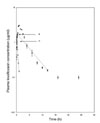1. Aliabadi FS, Lees P. Pharmacokinetics and pharmacodynamics of danofloxacin in serum and tissue fluids of goats following intravenous and intramuscular administration. Am J Vet Res. 2001. 62:1979–1989.

2. Apley MD, Upson DW. Lung tissue concentrations and plasma pharmacokinetics of danofloxacin in calves with acute pneumonia. Am J Vet Res. 1993. 54:937–943.
3. Arret B, Johnson DP, Kirshbaum A. Outline of details for microbiological assays of antibiotics: second revision. J Pharm Sci. 1971. 60:1689–1694.

4. Atef M, El-Gendi AY, Aziza , Amer MM, El-Aty AM. Some pharmacokinetic data for danofloxacin in healthy goats. Vet Res Commun. 2001. 25:367–377.
5. Baggot JD. Principles of Drug Disposition in Domestic Animals. 1977. Philadelphia: Saunders;190–218.
6. Bakken JS. The fluoroquinolones: how long will their utility last? Scand J Infect Dis. 2004. 36:85–92.

7. Chulavatnatol S, Chindavijak B, Vibhagool A, Wananukul W, Sriapha C, Sirisangtragul C. Pharmacokinetics of levofloxacin in healthy Thai male volunteers. J Med Assoc Thai. 1999. 82:1127–1135.
8. Davis R, Bryson HM. Levofloxacin. A review of its antibacterial activity, pharmacokinetics and therapeutic efficacy. Drugs. 1994. 47:677–700.
9. Edelstein PH, Edelstein MA, Lehr KH, Ren J.
In-vitro activity of levofloxacin against clinical isolates of Legionella spp, its pharmacokinetics in guinea pigs, and use in experimental
Legionella pneumophila pneumonia. J Antimicrob Chemother. 1996. 37:117–126.

10. Gibaldi M, Perrier D. Pharmacokinetics. 1982. 2nd ed. New York: Marcel Dekker;433–444.
11. Giles CJ, Magonigle RA, Grimshaw WTR, Tanner AC, Risk JE, Lynch MJ, Rice JR. Clinical pharmacokinetics of parenterally administered danofloxacin in cattle. J Vet Pharmacol Ther. 1991. 14:400–410.

12. Gips M, Soback S. Norfloxacin nicotinate pharmacokinetics in unweaned and weaned calves. J Vet Pharmacol Ther. 1996. 19:130–134.

13. Kaartinen L, Salonen M, Alli L, Pyorala S. Pharmacokinetics of enrofloxacin after single intravenous, intramuscular and subcutaneous injections in lactating cows. J Vet Pharmacol Ther. 1995. 18:357–362.

14. Klesel N, Geweniger KH, Koletzki P, Isert D, Limbert M, Markus A, Riess G, Schramm H, Iyer P. Chemotherapeutic activity of levofloxacin (HR 355, DR-3355) against systemic and localized infections in laboratory animals. J Antimicrob Chemother. 1995. 35:805–819.

15. Kunin CM, Dornbush AC, Finland M. Distribution and excretion of four tetracycline analogues in normal young men. J Clin Invest. 1959. 38:1950–1963.

16. Langtry HD, Lamb HM. Levofloxacin. Its use in infections of the respiratory tract, skin, soft tissues and urinary tract. Drugs. 1998. 56:487–515.
17. North DS, Fish DN, Redington JJ. Levofloxacin, a second-generation fluoroquinolone. Pharmacotherapy. 1998. 18:915–935.
18. Schneider M, Valle M, Woehrle F, Boisrame B. Pharmacokinetics of marbofloxacin in lactating cows after repeated intramuscular administrations and pharmacodynamics against mastitis isolated strains. J Dairy Sci. 2004. 87:202–211.

19. Shem-Tov M, Ziv G, Glickman A, Saran A. Pharmacokinetics and penetration of marbofloxacin from blood into the milk of cows and ewes. Zentralbl Veterinarmed A. 1997. 44:511–519.

20. Shojaee Aliabadi F, Landoni MF, Lees P. Pharmacokinetics (PK), pharmacodynamics (PD) and PK-PD integration of danofloxacin in sheep biological fluids. Antimicrob Agents Chemother. 2003. 47:626–635.

21. Singh K, Srivastava AK. Plasma levels, pharmacokinetics, urinary excretion and dosage regimen of ciprofloxacin in cross bred cow calves. J Punjab Acad Sci. 2000. 2:105–107.
22. TerHune TN, Skogerboe TL, Shostorm VK, Weigel DJ. Comparison of pharmacokinetics of danofloxacin and enrofloxacin in calves challenged with Mannheimia haemolytica. Am J Vet Res. 2005. 66:342–349.









 PDF
PDF ePub
ePub Citation
Citation Print
Print


 XML Download
XML Download